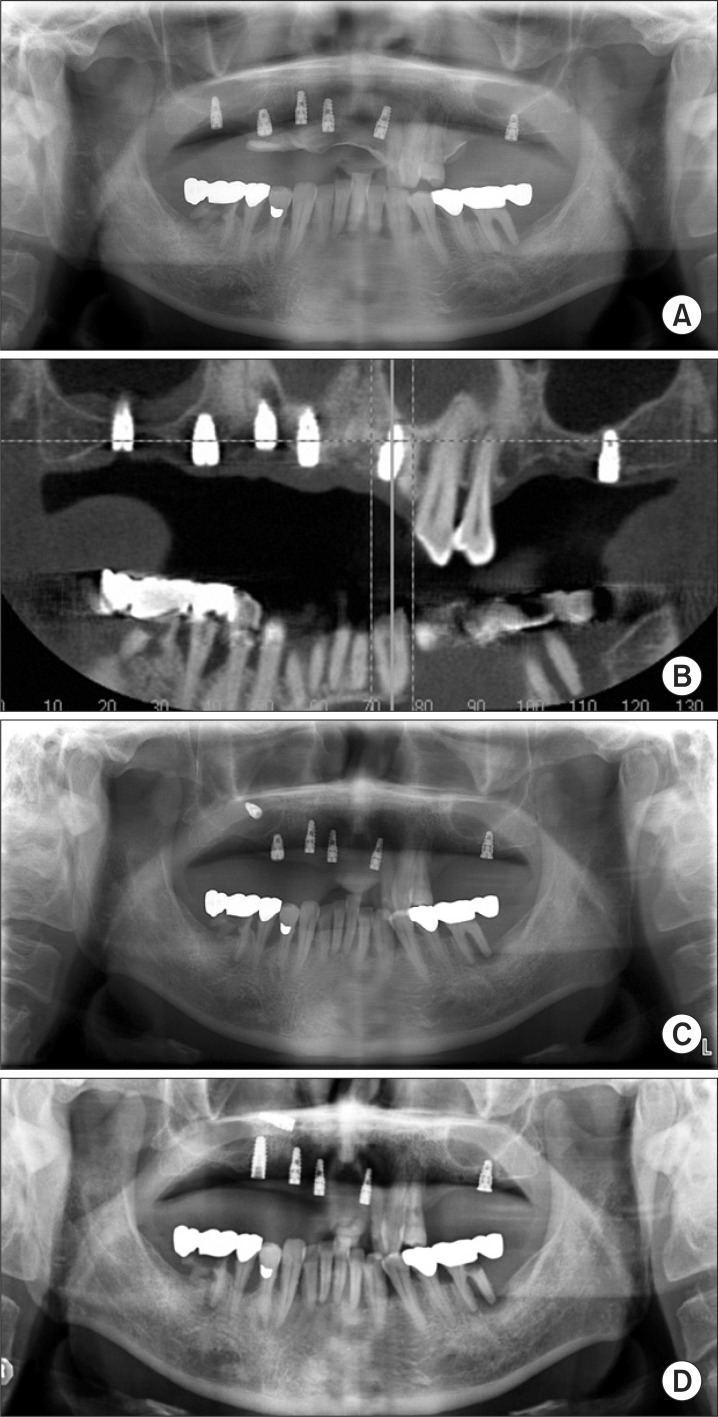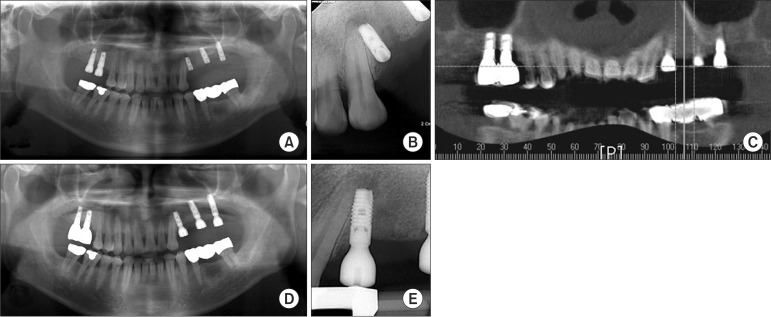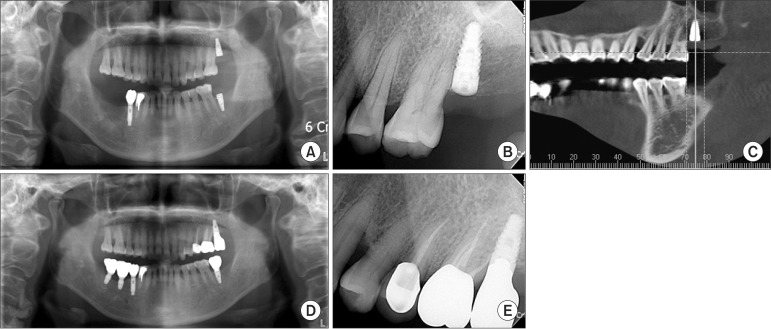J Korean Assoc Oral Maxillofac Surg.
2013 Jun;39(3):144-147. 10.5125/jkaoms.2013.39.3.144.
Prognosis and evaluation of tooth damage caused by implant fixtures
- Affiliations
-
- 1Department of Oral and Maxillofacial Surgery, School of Dentistry, Chosun University, Gwangju, Korea. sgckim@chosun.ac.kr
- 2Department of Dental Hygiene, Kangwon National University, Samcheok, Korea.
- KMID: 1430483
- DOI: http://doi.org/10.5125/jkaoms.2013.39.3.144
Abstract
- Damage to adjacent teeth is one of the various complications that may occur during implant placement and is often the result of improper direction during fixture placement or excessive depth of placement. In general, if detrimental symptoms, such as reaction to percussion in damaged teeth, mobility, and pulp necrosis, are not present, osseointegration should be observed at follow-up. In three cases, the possibility of root damage due to an implant fixture placed too close to each adjacent tooth was perceived on radiographs. However, in all of these cases, there were no clinical symptoms or radiographic changes present in the tooth, and the implants did not exhibit decreased stability or peri-implantitis. Therefore, we can carefully predict that the implant fixture close to the adjacent tooth did not invade the cementum of the root, and therefore did not produce the suspected pulpal damage or periradicular symptoms. In this study, we considered both the implant status as well as the adjacent tooth.
Keyword
MeSH Terms
Figure
Reference
-
1. Chee W, Jivraj S. Failures in implant dentistry. Br Dent J. 2007; 202:123–129. PMID: 17293814.
Article2. Goodacre CJ, Bernal G, Rungcharassaeng K, Kan JY. Clinical complications with implants and implant prostheses. J Prosthet Dent. 2003; 90:121–132. PMID: 12886205.
Article3. Misch K, Wang HL. Implant surgery complications: etiology and treatment. Implant Dent. 2008; 17:159–168. PMID: 18545047.
Article4. Sussman HI. Tooth devitalization via implant placement: a case report. Periodontal Clin Investig. 1998; 20:22–24.5. Sussman HI. Periapical implant pathology. J Oral Implantol. 1998; 24:133–138. PMID: 9893519.
Article6. Shabahang S, Bohsali K, Boyne PJ, Caplanis N, Lozada J, Torabinejad M. Effect of teeth with periradicular lesions on adjacent dental implants. Oral Surg Oral Med Oral Pathol Oral Radiol Endod. 2003; 96:321–326. PMID: 12973288.
Article7. Kim SG. Implant-related damage to an adjacent tooth: a case report. Implant Dent. 2000; 9:278–280. PMID: 11307415.8. von Arx T. Failed root canals: the case for apicoectomy (periradicular surgery). J Oral Maxillofac Surg. 2005; 63:832–837. PMID: 15944982.
Article9. Skoglund A, Persson G. A follow-up study of apicoectomized teeth with total loss of the buccal bone plate. Oral Surg Oral Med Oral Pathol. 1985; 59:78–81. PMID: 3856207.
Article10. Lindhe J, Berglundh T, Ericsson I, Liljenberg B, Marinello C. Experimental breakdown of peri-implant and periodontal tissues. A study in the beagle dog. Clin Oral Implants Res. 1992; 3:9–16. PMID: 1420727.
Article11. Tarnow DP, Eskow RN. Preservation of implant esthetics: soft tissue and restorative considerations. J Esthet Dent. 1996; 8:12–19. PMID: 9468826.
Article12. Napier ID. Reference doses for dental radiography. Br Dent J. 1999; 186:392–396. PMID: 10365461.
Article13. Tronje G, Eliasson S, Julin P, Welander U. Image distortion in rotational panoramic radiography. II. Vertical distances. Acta Radiol Diagn (Stockh). 1981; 22:449–455. PMID: 7331857.
- Full Text Links
- Actions
-
Cited
- CITED
-
- Close
- Share
- Similar articles
-
- Dental Implant Fractures: A Report of 43 Implant Fixtures in 33 Patients
- Finite element analysis of fin-type implant fixtures
- Finite element stress analysis of maxillary two implants-retained overdenture according go position of implant fixtures
- Influence of the adjacent periodontium and inter-implant distance on bone resorption around non-submerged implants: A retrospective clinical and radiographic study
- Implant Fixture Installation in the Posterior Maxilla Using a Tooth-supported Surgical Template Based on Computer Assisted Treatment Planning




